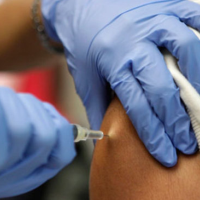Whooping Cough Cases in State Soar Despite Change in Vaccine Law
 (photo: Associated Press)
(photo: Associated Press)
It is not 2010, when whooping cough cases hit epidemic levels in California, but health officials are concerned that cases of the disease doubled in the state last year and linked it to people who reject taking the vaccine.
The Sacramento Bee reported last week that state officials had documented 1,669 cases of whooping cough (pertussis) in 2013, compared to 1,023 the year before. That would be an increase of 63%, but even that startling number appears to be low. The California Department of Public Health reported last December 18 that reported pertussis cases had already reached 1,904 (pdf) and when the final numbers are reported in the spring they may show a doubling from the year before.
Nobody died in 2013, but 111 patients ended up in the hospital. The bacterial disease is highly contagious and deadly, especially for infants, who cannot be vaccinated. It is spread when people sneeze or cough, spewing droplets with bacteria into the air. One person with pertussis can infect as many as fifteen other people.
Sixty-three percent of the California cases involved infants under 4 months of age and 82% were children under the age of 18.
Three years after an epidemic of whooping cough—largely eliminated from the general population for 53 years—struck 9,120 people in California in 2010 and killed 10 infants, researchers blamed the outbreak on parents who refused to vaccinate their kids. A study published last year in the journal Pediatrics said that people who refused vaccinations for their children, largely for religious reasons, were 2.5 times more likely to be living in areas where whooping cough appeared.
Californians can skip vaccinations for religious reasons and don’t have to explain that is their reason. But in 2012, the state passed a law requiring parents who opt out to sign a document that verifies they understand the benefits of vaccines.
It doesn’t take a lot of people claiming a pertussis exemption in school for their kids to have an effect on the area. Scientists say that once fewer than 95% of people are vaccinated, a community loses “herd” immunity. Only 91% of California kindergartners statewide were vaccinated as of 2010, but researchers found that in some areas, as high as 84% of students received non-medical vaccine exemptions. (Some people cannot be vaccinated because of other medical issues.)
Blame for the outbreak in 2010 of the bacterial infection wasn’t laid entirely on the exempted students. Pertussis appears in a cyclical fashion and the vaccine’s protection is now known to fade quicker than originally thought. So older kids are probably more susceptible, as are adults who didn’t receive a booster shot.
Nationally, the Centers for Disease Control and Prevention (CDC) provisionally reported a large drop in whooping cough in 2013, from 48,277 cases in 2012 to 24,231.
–Ken Broder
To Learn More:
Whooping Cough on the Upswing in California (by Connie Goldsmith,
More Whooping Cough Cases Reported by California, Counties (by Cynthia H. Craft, Sacramento Bee)
Vaccine Refusal Linked to California Pertussis Outbreak (by Michelle Healy, USA Today)
Unraveling the Whooping Cough Epidemic (by Kathleen Doheny, WebMD)
Pertussis (Whooping Cough) (California Department of Public Health)
California Whooping Cough Epidemic Connected to Anti-Vaccine Parents (by Ken Broder, AllGov California)
Pertusis Report (California Department of Public Health) (pdf)
- Top Stories
- Controversies
- Where is the Money Going?
- California and the Nation
- Appointments and Resignations
- Unusual News
- Latest News
- California Forbids U.S. Immigration Agents from Pretending to be Police
- California Lawmakers Urged to Strip “Self-Dealing” Tax Board of Its Duties
- Big Oil’s Grip on California
- Santa Cruz Police See Homeland Security Betrayal in Use of Gang Roundup as Cover for Immigration Raid
- Oil Companies Face Deadline to Stop Polluting California Groundwater





